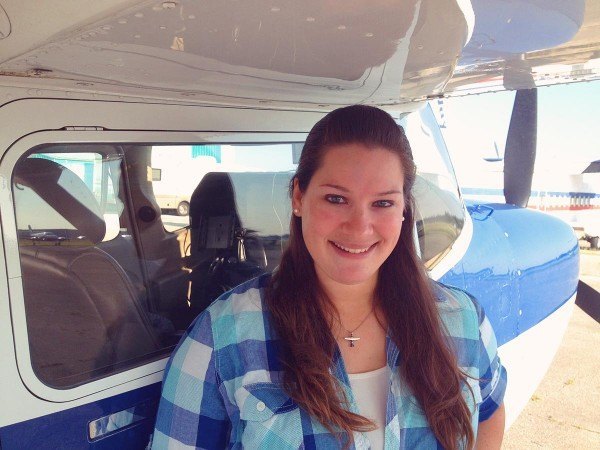Shana Bartell
Bird Strike
by Sarah Rovner (Commercial Pilot and FAASTeam Representative)
For a few weeks after my night engine failure and resulting accident, it seemed that I could not have an uneventful flight in a small airplane. As I started getting back into flying, I was looking for any and every way to build time to progress in my training. At the time I was still somewhat nervous in the airplane and this flight was my first time flying solo since the accident. I needed the cross country time for my instrument rating, and flying with Civil Air Patrol was one of the most cost effective ways of doing it. On February 21, 2012 I decided that I would commute from Lone Star Executive Airport in Conroe to West Houston Airport for my Civil Air Patrol meeting. Since I was a bit early to the airport, I figured I had enough time to turn the flight into a cross country so I could log it toward my instrument rating. I decided to fly from Conroe to Galveston and then head to West Houston Airport.
Before the flight, I received a weather briefing that predicted low ceilings along the coast but were not scheduled to form until later in the evening. After taking off from Lone Star, I headed south toward Galveston. I was receiving flight following services and about halfway to Galveston when the controller came on the radio and told me that clouds were forming at 500ft over the airport. At first they were few, then scattered, and I figured it was just a matter of time before it was broken or overcast and decided it would be best to skip the trip to Galveston. I decided to take the VFR corridor along I-10 from the San Jacinto Monument to West Houston airport. After I turned to follow the corridor, I looked down to see cars lined bumper to bumper on I-10 in rush hour traffic. As I passed downtown Houston, out of nowhere a bird hit the airplane. Its guts were splattered all across the windshield and my heart started to race. I looked down at I-10 again and thought to myself “I can’t land there”. I didn’t know if the bird had gotten into the engine cowling or intakes, and I am not enough of a mechanical person to know what that would have done. All I could think of was how I didn’t want another engine failure and told ATC I wanted to divert and make a precautionary landing.
ATC advised that Hobby Airport was closest as it was about 5 miles away. Being a regular visitor to Hobby in small planes, I thought nothing of it. Once again I relayed to ATC that it was NOT an emergency and that I just wanted to land and take a look at it. As I lined up for the runway, they cleared me to land on 12L. They had turned out the lights on all the other runways except 12L. On short final, I could see emergency vehicles approaching the runway. I told the tower that it was not an emergency, and the controller said they were just there as a precaution. After I landed, the fire department vehicles surrounded the airplane and drove around it in circles looking for a fire. I voiced my frustration to ground, saying that I had just hit a bird and wanted to look outside of the airplane for damage. Little did I know, I had just shut down Hobby airport. They finally came back and let me taxi to Million Air where I inspected the airplane. There was no damage and I cleaned the bird off after the Airport Environmental Operations Coordinator took a swab of the bird to submit for testing. It was nice to see how serious they took bird strikes, but I felt the response was a bit excessive considering the circumstances.
The FAA does request that pilots submit information on bird strikes for their Wildlife Strike Database. The link to submit a bird strike is: http://wildlife.faa.gov. You have the option of submitting a new report, editing an old report, and even submitting remains of the bird for testing.
It is always a good practice to be cautious, and bird strikes can definitely be more severe than what I experienced. Many airports have developed their own programs to minimize the risk of wildlife encounters, ranging from birds to deer and hogs.  However, it is still a very real danger and something pilots should be aware of. I’ve seen birds (and grasshoppers) as high as 9,000ft, and I would recommend all pilots be on the lookout and aware of their surroundings to minimize the risk of hitting wildlife. As always, fly safe!
However, it is still a very real danger and something pilots should be aware of. I’ve seen birds (and grasshoppers) as high as 9,000ft, and I would recommend all pilots be on the lookout and aware of their surroundings to minimize the risk of hitting wildlife. As always, fly safe!
Sarah Rovner is a commercial airplane pilot based in Houston, TX who enjoys flying her G1000-equipped Cessna 182 for personal and business travel. She is also active as a mission pilot in the Civil Air Patrol, a humanitarian pilot with Angel Flight, a tow pilot for a local glider field, FAASTeam Representative and EAA Young Eagles pilot. She enjoys flying to and exploring new places, and is currently working toward her CFI rating.
Would you like more information?
Send us a message below.

